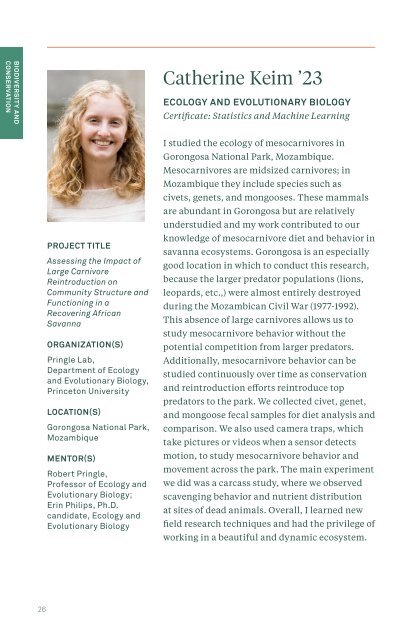Environmental Internship Program - 2022 Booklet
Create successful ePaper yourself
Turn your PDF publications into a flip-book with our unique Google optimized e-Paper software.
BIODIVERSITY AND<br />
CONSERVATION<br />
Catherine Keim ’23<br />
ECOLOGY AND EVOLUTIONARY BIOLOGY<br />
Certificate: Statistics and Machine Learning<br />
PROJECT TITLE<br />
Assessing the Impact of<br />
Large Carnivore<br />
Reintroduction on<br />
Community Structure and<br />
Functioning in a<br />
Recovering African<br />
Savanna<br />
ORGANIZATION(S)<br />
Pringle Lab,<br />
Department of Ecology<br />
and Evolutionary Biology,<br />
Princeton University<br />
LOCATION(S)<br />
Gorongosa National Park,<br />
Mozambique<br />
MENTOR(S)<br />
Robert Pringle,<br />
Professor of Ecology and<br />
Evolutionary Biology;<br />
Erin Philips, Ph.D.<br />
candidate, Ecology and<br />
Evolutionary Biology<br />
I studied the ecology of mesocarnivores in<br />
Gorongosa National Park, Mozambique.<br />
Mesocarnivores are midsized carnivores; in<br />
Mozambique they include species such as<br />
civets, genets, and mongooses. These mammals<br />
are abundant in Gorongosa but are relatively<br />
understudied and my work contributed to our<br />
knowledge of mesocarnivore diet and behavior in<br />
savanna ecosystems. Gorongosa is an especially<br />
good location in which to conduct this research,<br />
because the larger predator populations (lions,<br />
leopards, etc.,) were almost entirely destroyed<br />
during the Mozambican Civil War (1977-1992).<br />
This absence of large carnivores allows us to<br />
study mesocarnivore behavior without the<br />
potential competition from larger predators.<br />
Additionally, mesocarnivore behavior can be<br />
studied continuously over time as conservation<br />
and reintroduction efforts reintroduce top<br />
predators to the park. We collected civet, genet,<br />
and mongoose fecal samples for diet analysis and<br />
comparison. We also used camera traps, which<br />
take pictures or videos when a sensor detects<br />
motion, to study mesocarnivore behavior and<br />
movement across the park. The main experiment<br />
we did was a carcass study, where we observed<br />
scavenging behavior and nutrient distribution<br />
at sites of dead animals. Overall, I learned new<br />
field research techniques and had the privilege of<br />
working in a beautiful and dynamic ecosystem.<br />
26
















